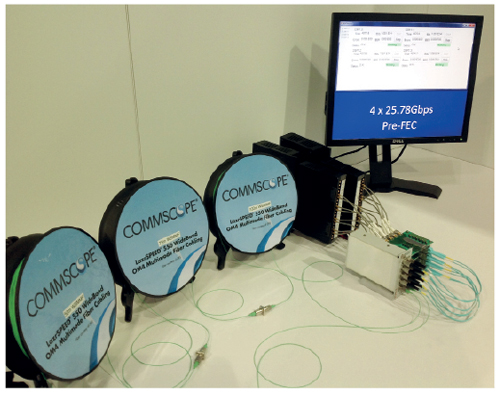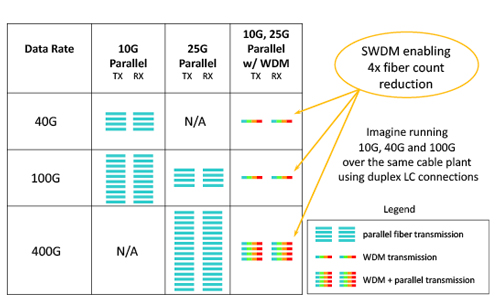Multimode fibre has been the workhorse of data centre networks for many decades because it provides the lowest cost cabling system for high-speed connections between servers, switches and storage. Although the optical fibre is more expensive, the larger core size enables the use of cheaper transmitters based on vertical-cavity surface-emitting lasers (VCSELs), which reduces the overall cost of the system.
Mega data centre operators like Google and Facebook are expected to adopt singlemode fibre in the future, taking advantage of singlemode fibre’s ability to support higher capacities over longer distances. Facebook recently stated that its new data centre in Altoona, Iowa, which is built using 40-Gb/s links, will be its last to use multimode fibre.
However, there is still a vast installed base of legacy equipment in data centres which will continue to play an important role in the overall data centre market. Those operators are looking for cost-effective upgrade paths for their existing networks, as Craig Thompson, director of strategic marketing at Finisar, explains.
Thompson said: ‘It is a storyline in our industry that has not gotten a lot of attention recently because there has been so much attention on the dozen or so companies that are building very large data centres. The fact of the matter is that the majority of the enterprise customer base does not require the sort of infrastructure that the web-scale companies are demanding.’
According to research firm Gartner, 94 per cent of all data centre sites built in 2014 were smaller than 250,000 square feet, and this percentage is not expected to change in the next five years. A 300m optical link is sufficient for even the longest distances inside a 250,000 square foot data centre, Thompson contends.
He added: ‘We felt compelled to just put a spotlight back on the rest of the industry that needs continued investment in low-cost multimode fibre. What we are aiming to do is continue to provide that value to the customers so they can continue to buy the lowest cost transceivers and get the lowest cost connectivity for these long distances at these higher data rates.’
Technology roadmap
At OFC 2015 in Los Angeles earlier this year Finisar unveiled its technology roadmap for next-generation multimode fibre interfaces. The roadmap provides a route to higher speeds, both for the installed base of multimode fibre and using new fibre types in the future. Three key technologies will make this possible: wavelength division multiplexing, higher serial lane rates, and new multimode fibre types that have been optimised around these capabilities.
At the show Finisar demonstrated a proprietary 40G ‘SWDM4’ transceiver in a QSFP+ form factor, capable of 300m transmission over duplex OM3 multimode fibre. The device employs what the company calls shortwave WDM (hence SWDM) with four 10Gb/s wavelengths over a fibre pair, one fibre for each direction. At less than 1.5W power consumption, the transceiver enables a simple upgrade for data centres that have previously deployed duplex multimode fibre at 10Gb/s.
In the past few years, VCSELs supporting data rates of 25Gb/s have reached the market. Combining SWDM with 25Gb/s VCSELs enables 100G transmission over duplex multimode fibre. Finisar also demonstrated a prototype 100Gb/s module capable of 70m transmission over duplex OM3 multimode fibre and 100m over OM4 fibre, and expects to be able to increase the reach to 300m with further product development. Future development of VCSELs that operate at 50Gb/s will enable even faster generations of both single-lane and multiple-lane optical interfaces.
Also at OFC 2015, Finisar’s transceiver technology was used by CommScope to demonstrate 100 Gigabit Ethernet transmission over duplex multimode fibre. The demo operated error free without the assistance of forward error correction (FEC) over 100m of CommScope’s LazrSPEED 550 OM4 fibre and over 225m of LazrSPEED 550 WideBand, a new type of fibre that has been optimised for SWDM transmission. The demonstration, held over a few hours by invitation only on Finisar’s booth, was the first to show the capabilities of wideband multimode fibre (WBMMF).

Figure 1: CommScope and Finisar demonstrated 100G transmission with 225m reach over WBMMF at OFC 2015
Finisar and CommScope were not the only companies focusing on enhancements to multimode fibre transmission at OFC this year. Avago Technologies demonstrated its VCSEL-based optical 4-level pulse-amplitude modulation (PAM-4) technology for next-generation optical transceivers. PAM-4 uses four distinct amplitude levels, each representing a combination of two bits (00, 01, 11, 10), effectively doubling the data rate for the same symbol rate. The vendor also showed a prototype 40G bidirectional (BiDi) QSFP+ transceiver that has since started shipping in volume. Each fibre carries two 20G wavelengths travelling in opposite directions to give 40G of capacity on duplex multimode fibre.
On its stand, OFS showcased several new interfaces for multimode fibre, including a demonstration using a third-party 40G BiDi module to connect 40 Gigabit Ethernet switches over 200m of duplex OM4 fibre. The optical module from Cisco, announced with the vendor’s Nexus 9000 family of data centre switches, is based on 10G wavelengths at 850nm and 900nm travelling in opposite directions simultaneously on both of the duplex fibres.
The optical transceivers from Avago and Cisco represent the first commercial applications for SWDM. Both operate over duplex fibre with an LC connector – as opposed to eight fibres with the MPO connector used by conventional 40GBASE-SR4 optics. Thus they provide a simple drop-in upgrade to 40 Gigabit Ethernet for data centre networks previously running at 10G over duplex multimode fibre. The technology inside the Avago and Cisco modules is proprietary. However, as the joint demonstration from CommScope and Finisar indicates, further optimisation and standardisation of SWDM technology will allow multimode fibre transmission to reach much higher capacities.
Technical challenges
Although SWDM is possible using legacy cable plant, the technology is not ideal for multiple wavelengths. Current OM3 and OM4 multimode fibre is optimised for single-wavelength VCSELs operating in a narrow wavelength range around 850nm, and the modal bandwidth of the fibre drops off quickly at wavelengths above this value. Wideband multimode fibre and compatible transceivers are required to fully utilise the increase in bandwidth without suffering a reduction in reach.
‘The main challenge that we have with using short-range wavelength multiplexing over wideband fibre is to strike the correct balance between supporting the legacy applications that operate at 850nm while also providing a better transmission capability for other wavelengths,’ explained Paul Kolesar, engineering fellow in the Enterprise Solutions division of CommScope.
The problem is dispersion. In multimode fibre there are two primary causes of dispersion. One is caused by the differences in propagation velocity between the many modes in a multimode fibre, called modal dispersion. The second is caused by the differences in propagation velocity of different wavelengths, or colours, of light, called chromatic dispersion. Their reciprocal functions are called modal bandwidth and chromatic bandwidth, respectively. Each dispersion mechanism causes the pulses of light that carry information to spread out in time as they propagate.
Kolesar commented: ‘In practical terms, the total bandwidth cannot be higher than either the modal bandwidth or the chromatic bandwidth, and in reality it is always lower than either of the two. It is important to try to keep the two in balance because raising one very high has diminishing benefit if the other is not also raised.’
Wideband multimode fibre is designed to support wavelengths longer than 850nm because this allowed designers to take advantage of the cables’ naturally occurring reduction in chromatic dispersion as the wavelength lengthens. ‘We get an improvement in the chromatic bandwidth by going to longer wavelengths,’ Kolesar noted. ‘Wideband fibre will also increase the modal bandwidth for these longer wavelengths compared to OM4. Overall the net effect will be to provide OM4-like capability over a broader wavelength range of 100nm or more. This range is sufficient to support four low-cost wavelengths while also supporting all of the legacy applications of today.’
Input from optical transceiver and systems manufacturers was also vital, otherwise ‘the transceiver could be so expensive that the total system cost would not be acceptable,’ commented John Kamino senior product manager for multimode fibre at OFS. Developers need to be aware of the capabilities of the fibre and any proposed changes to the system, as this can affect the wavelength grid – a table of all the central frequencies (and corresponding wavelengths) of channels allowed in a given system.
Finisar’s Thompson agreed: ‘It does take time and a number of iterations to agree on what the wavelength grid should be, what channels should be supported to achieve the length distances, and the power consumption that the industry needs.’
He added: ‘It was important for us to support links on installed fibre. There are a lot of 10-gigabit links out there today that go 300m, and so we took more time and spent considerable amount of R&D dollars to create a wavelength grid and a link model that would support WDM multimode up to 300m, even on legacy fibre.’
Product development also has to align with consumer demand and the timing for market entry is crucial. Pure technology is not the only consideration, says CommScope’s Kolesar and he offered a cautionary tale.
‘IEEE 802.3 defined an Ethernet physical layer at 10Gb/s called 10GBASE-LX4,’ he recalled. ‘It was a four-wavelength interface, designed to enable the legacy plant of that day, which was OM1 and OM2 multimode fibre.’ The LX4 used wavelengths in the 1300nm range, which is typically used with singlemode fibre. As such it employed singlemode lasers with the more stringent singlemode alignment tolerances rather than the cheaper VCSELs that are used today.
‘The technology was eclipsed by the adoption of OM3 fibre which allowed a simpler, serial, VCSEL-based solution known as 10GBASE-S, which is what still is in use today,’ said Kolesar. He also noted that an exclusivity agreement prevented LX-4 from being well sourced and supplied – consequently its market penetration was small.
Heeding the lessons of the past, both fibre and transceiver manufacturers hope to encourage adoption of SWDM-based products by ensuring that standards are in place early in the process so that vendors can develop products to a common specification.
Structured cabling standards
Multimode fibre standards are developed under TR42, the structured cabling committee of the Telecommunications Industry Association (TIA). CommScope’s Paul Kolesar has chaired the TR42.11 subcommittee on fibre optic systems for around 10 years. He said: ‘I was the one who introduced OM3 and OM4 to the industry and this will be my third attempt at bringing an evolution to multimode transmission through wideband fibre,’ he noted.
Third time lucky, it would seem. At the group’s October 2014 meeting, CommScope’s proposal to initiate a project to develop the wideband multimode fibre specification received significant support and was able to get underway. The output will be a new fibre specification to be published as TIA-492AAAE.
‘Projects can get started in any number of ways,’ explained Kolesar. ‘With this particular one we had worked behind the scenes with a number of the key players so that when everyone felt well-enough prepared we went in together to make a multi-company proposal and that was quite powerful.’
‘We are hoping that most of the technical work will be completed sometime in early to mid-2016 time frame,’ said Kamino from OFS. ‘If you are familiar with the standards process you know that necessarily having the technical agreement does not mean that the document published in that time frame but everyone has a pretty good idea of what is going on.’
Kamino notes that although standards development is a time consuming, complex process, it is a necessary process to deliver a well-balanced, low-cost solution. He said: ‘What you do not want to do is optimise the fibre without any idea of the limitations of the devices and systems. That is why we try and get input from all of these different groups.’ Not only does this entail working with manufacturers of fibre and cable, but also working with other standards groups to make sure that the new hardware will be able to support future applications.
Standards bodies are always anticipating the next step in technology. ‘The IEEE is likely to initiate a study group for 50 Gigabit Ethernet within the next two plenary meetings, say within the next six months or so,’ said Kolesar. The scope is likely to include a four-lane variant to provide 200-Gb/s links. In addition he notes that the International Committee for Information Technology Standards (INCITS) T11 committee, which defines Fibre Channel interconnection schemes, is already considering the next generation of Fibre Channel interface that includes single-lane and four-lane variants based on 50Gb/s. SWDM would allow both of these four-lane standards to be delivered using a two-fibre duplex interface. ‘It is also possible that these applications standards bodies will revisit existing data rates to define next-generation SWDM variants for 100G or 128G Fibre Channel,’ Kolesar added.
The standards work will certainly not end there. ‘This opens up new areas of growth beyond the current standards that are being worked on such as 100G or 400G. There is already talk of speeds beyond 400G, and this [WBMMF] offers a novel way of being able to support these data rates,’ said Kamino.
He concluded: ‘The advent of WDM coupled with higher speeds for VCSELs and multimode fibre will make it possible to achieve 400Gb/s and even 1.6Tb/s in compact cable structure, such that multimode fibre links are likely to remain the low-cost paradigm in enterprise data centres for years to come.

Figure 2: Parallel cables in combination with shortwave WDM will enable cost effective 100G and 400G transmission over multimode fibre

